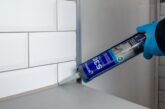
How do you make sure you’re using the right sealant for the job? Saint-Gobain Abrasives provides a guide
Decorators play a pivotal role in transforming spaces into beautiful, functional and aesthetically pleasing environments. But achieving that flawless finish demands attention to detail, one often underestimated element is sealing cracks and gaps. Nick Bratt, National Sales Manager at OneBond, part of Saint-Gobain Abrasives, delves into how decorators can elevate their projects with the right tools and knowledge.
Cracks and gaps, when left unaddressed, can pose significant challenges to any decorating project. These seemingly minor imperfections can lead to moisture intrusion, compromise structural integrity, encourage mould growth and ultimately diminish the look of a space. Unsealed gaps can also disrupt insulation, resulting in energy inefficiency and higher utility bills – something extremely topical and crucial to customer satisfaction, particularly over the winter months.
When it comes to caulking and sealing, choosing the correct products is critical in making or breaking any decorating project. They offer visual enhancement and a range of practical benefits, including improved insulation around doors, windows and other openings, moisture and mould prevention (particularly in areas prone to humidity like kitchens and bathrooms) and even pest control – all ensuring a hygienic living or working environment.
Choosing the correct caulking and sealing products depends on various factors, including the type of surface, location and the specific sealing purpose.

The key distinction between caulk (acrylic sealant) and other sealants is elasticity. Caulk is typically made from a mixture of latex and acrylic materials, which make it more rigid and prone to shrinking when cured. Sealants offer superior elasticity and water resistance as they primarily contain silicone, making them the more popular choice for many decorators.
Different surfaces demand different sealants. For example, the sealant used on wooden trim may differ from what’s best for concrete or metal surfaces. What colour sealant do you require? Will the sealant need to be painted once cured? Always consider the material and application you’re working with.
Indoor and outdoor applications also have unique requirements. Outdoor sealants must endure harsh weather conditions, UV rays and temperature fluctuations, while indoor sealants prioritise aesthetics, insulation and moisture control.
Identifying the primary purpose of your sealing project is the first step in choosing the correct product. Are you sealing gaps for aesthetics, insulation, moisture prevention, or all three? The intended function will guide your choice of sealant.
Be sure to evaluate the expected wear and tear on the sealed area. High-traffic areas or those subject to frequent movement may require more robust and flexible sealants.
There are many types, brands and formulas of sealants on the market; it can be challenging to know where to start. So, what should you be looking for?
![]()
Silicone sealants:
Ideal for: Wet areas, glass and non-porous surfaces.
Benefits: Highly resistant to moisture and UV rays, making them suitable for indoor and outdoor applications. They provide excellent flexibility and sealing properties, and sanitary sealants are available for areas such as bathrooms, wet rooms and kitchens to prevent mould growth.
Product recommendation: OneBond’s Silicone Multipurpose, for sealing window frames, kitchen backsplashes and countertops.
Hybrid Sealants:
Ideal for: Interior projects, drywall and baseboards.
Benefits: Most hybrid sealants work as an adhesive and sealant, offering decorators exceptional versatility. These products suit various applications, including wood, metal, concrete and glass surfaces. They are easy to apply, paintable and ideal for interior projects where flexibility and quick drying are essential. Due to their versatility, a few options can be available for specific applications, so it’s worth reading the product packaging to check which product suits your needs.
Product recommendation: OneBond’s MS Hybrid range, which includes ultra-clear products for tiles and glass, or medium-to-strong multipurpose products for filling joints, siding roofing and sealing openings.

Acrylic sealants:
Ideal for: Indoor projects with low to moderate movement.
Benefits: Dries quickly and is easy to clean up. Typical applications include sealing gaps between walls, window frames and doors. Once cured, they can be painted without affecting the properties of the sealant.
Product recommendation: OneBond’s Acrylic Universal for sealing cracks and household joints and assembling joinery.
Polyurethane sealants:
Ideal for: Interior and exterior projects, concrete and high-movement areas.
Benefits: Polyurethane sealants, or PU sealants, are known for their durability and flexibility and can withstand extreme weather conditions, making them perfect for sealing gaps in outdoor environments. Once cured, they can be painted without affecting the properties of the sealant.
Product recommendation: OneBond’s PU40, is used to fill expansion joints and seal joints between concrete structures, brickwork and masonry, amongst much more.
Each of these sealants offers distinct advantages and is suited to specific applications. By understanding their unique properties, and best use cases, decorators can make informed decisions when choosing the right sealant for their projects, ensuring a successful and long-lasting finish.
The devil is in the detail when it comes to decorating projects and selecting the correct sealing product is a detail decorators cannot afford to overlook. Whether it enhances the aesthetics of an indoor space or protects the integrity of an outdoor project, the right products are pivotal to the outcome.
To learn more about the OneBond range of sealants, visit http://www.onebondadhesives.com.







